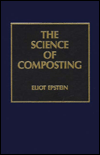

Hardcover
-
PICK UP IN STORECheck Availability at Nearby Stores
Available within 2 business hours
Related collections and offers
Overview
The main objective of composting is to transform organic materials into a stable usable product. Often organic materials which may have limited beneficial use in their raw state or have regulatory disposal constraints can be transformed by composting into marketable products. The limits on beneficial reuse may be regulations or they may be due to the potential for materials to be putrescible or pathogenic. Composting can be a solution for each of these.
The implementation of composting on a large scale (in contrast to home or backyard composting) involves materials handling. Technological implementation of composting must be consistent with the biological demand of the system. If the biological system is violated, conditions will not be optimized for composting, and problems such as odor generation, insufficient aeration or moisture, or a combination of these conditions may result. Past problems and closure of facilities have been largely due to violations of the biological systems. Product quality with respect to particle size, inclusions, moisture content and other physical aspects are a function of engineering design. A well designed system must have the biological and engineering principles in harmony at all times.

Product Details
| ISBN-13: | 9781566764780 |
|---|---|
| Publisher: | Taylor & Francis |
| Publication date: | 12/17/1996 |
| Pages: | 504 |
| Product dimensions: | 6.00(w) x 9.00(h) x (d) |
Read an Excerpt
The main objective of composting is to transform organic materials into a stable usable product. Often organic materials which may have limited beneficial use in their raw state or have regulatory disposal constraints can be transformed by composting into marketable products. The limits on beneficial reuse may be regulations or they may be due to the potential for materials to be putrescible or pathogenic. Composting can be a solution for each of these.
The implementation of composting on a large scale (in contrast to home or backyard composting) involves materials handling. Technological implementation of composting must be consistent with the biological demand of the system. If the biological system is violated, conditions will not be optimized for composting, and problems such as odor generation, insufficient aeration or moisture, or a combination of these conditions may result. Past problems and closure of facilities have been largely due to violations of the biological systems. Product quality with respect to particle size, inclusions, moisture content and other physical aspects are a function of engineering design. A well designed system must have the biological and engineering principles in harmony at all times."
Table of Contents
PrefaceComposting: A Prospective
Composting and Recycling
History
Philosophical Aspects and the Future of Composting in the United States
Advantages and Disadvantages of Composting
Conclusion
References
Basic Concepts
Introduction
Oxygen and Aeration
Moisture
Temperature
Nutrients: Carbon, Nitrogen, pH
Summary
References
Microbiology
Introduction
Microbial Populations
Temperature
Moisture
Nutrients
Inoculants
Summary
References
Biochemistry
Introduction
Organic Matter
Biochemical Manifestations Occurring during Composting
Biochemical Manifestations Occurring When Compost Is Applied to Soil
Humus Formation
Summary
References
Stability, Maturity, and Phytotoxicity
Introduction
Stability and Maturity:
Chemical Methods
Carbon/Nitrogen Ratio (C/N)
Nitrogen Species
pH
Cation Exchange Capacity (CEC)
Organic Chemical Constituents
Humification Parameters Humification Index
Relative Concentrations of Humic Acid to Fulvic Acid
Humic Substance
Functional Groups
Optical Density Physical Methods
Temperature and Heat Output
Color, Odor, Structure and Specific Gravity
Plant Assays
Microbiological Tests and Activities Respiration-Carbon Dioxide Evolution
Respiration-Oxygen Uptake
Microbial Changes
Enzyme Activity Phytotoxicity
Summary
References
Trace Elements, Heavy Metals, and Micronutrients
Introduction
Essentiality and Toxicity Arsenic (As)
Boron (B)
Cadmium (Cd)
Copper (Cu)
Lead (Pb)
Mercury (Hg)
Molybdenum (Mo)
Nickel (Ni)
Selenium (Se)
Zinc (Zn)
Occurrence in the Environment
Environmental Consequences Leachate Characteristics of Compost
Soil-Plant Interactions Type of Trace Element and Chemical State
Soil Acidity
Organic Matter
Cation Exchange Capacity (CEC)
Reversion to Unavailable Forms
Other Asp
